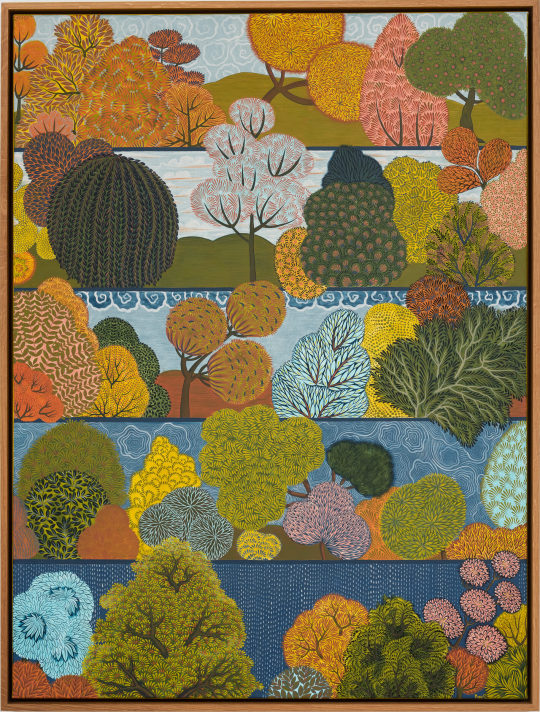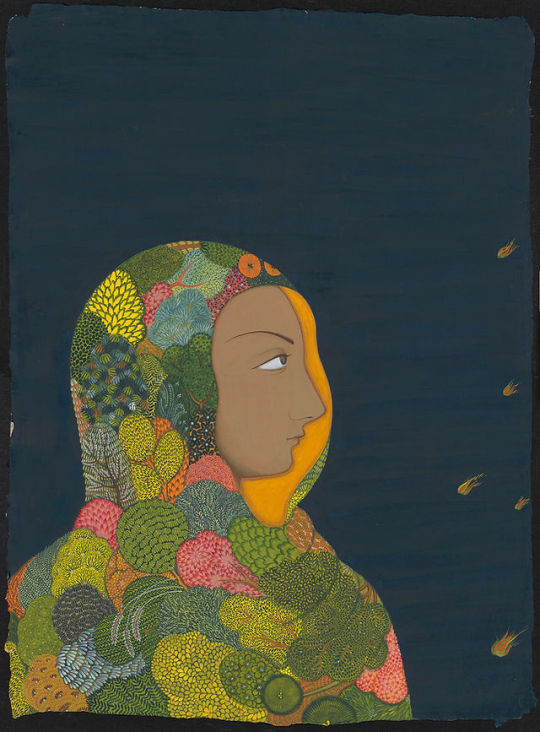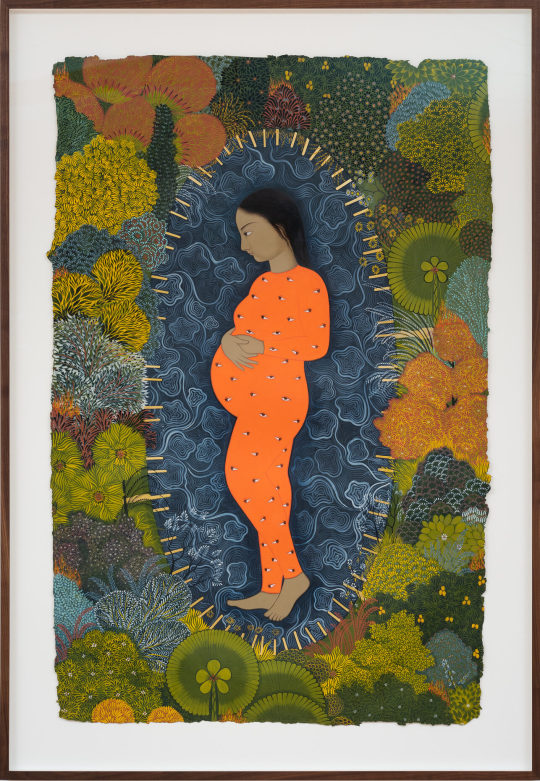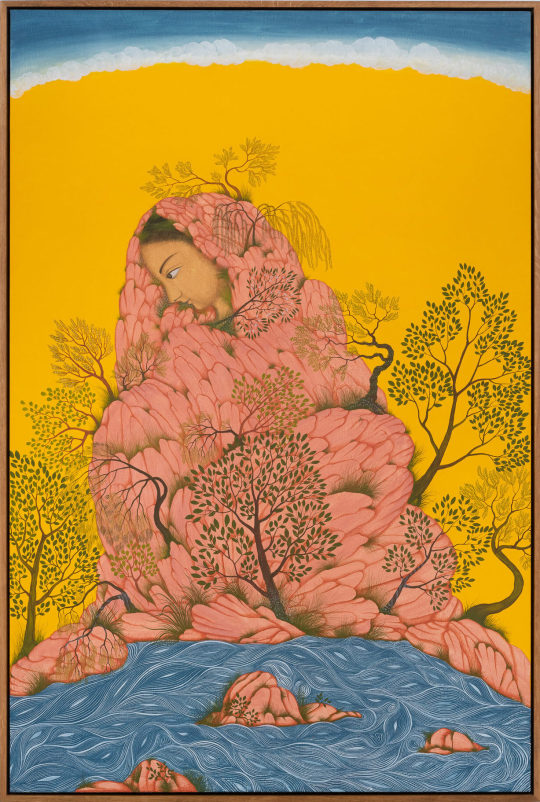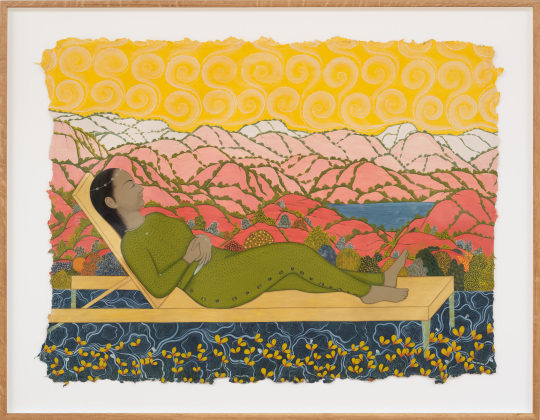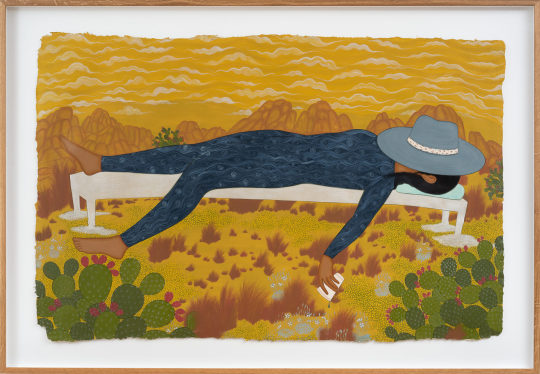#rupy c tut
Text

Rupy C. Tut
“Searching for Ancestors” (2023)
handmade pigments on linen
71 notes
·
View notes
Text
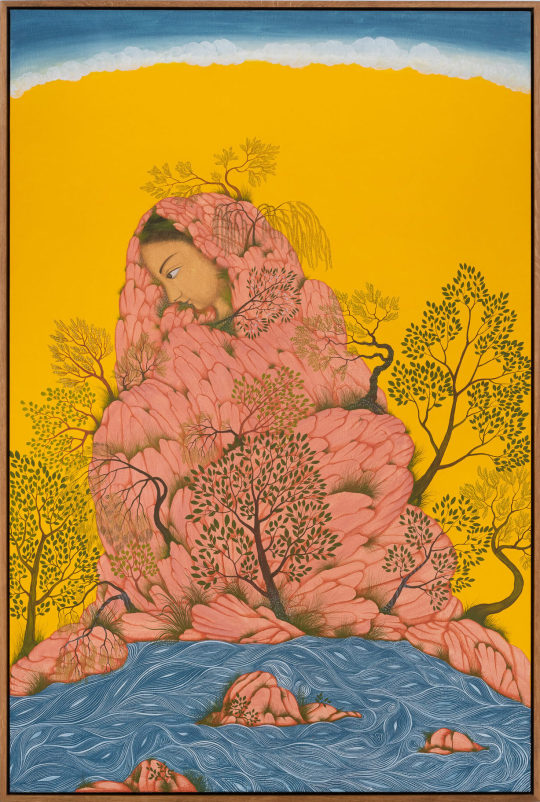
In Rupy C. Tut’s Dreamlike Paintings, Figures Fold Into Landscapes in a Struggle to Belong
160 notes
·
View notes
Text




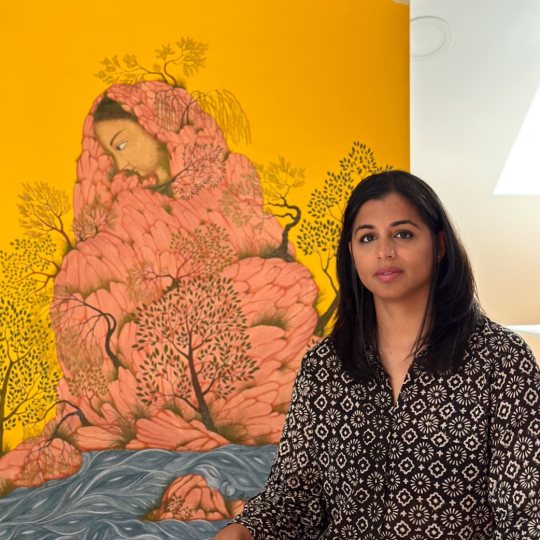

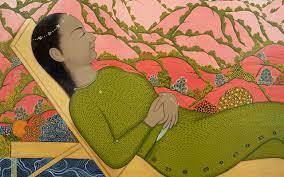
Rupy C. Tut (b 1985) is an Oakland-based visual artist. Tut’s work is particularly remarkable for her use of traditional materials and methods associated with calligraphy and Indian miniature painting.
As a descendant of refugees and a first generation immigrant, Rupy’s family narrative of movement, loss, and resilience is foundational to her creative inquiries.
21 notes
·
View notes
Text

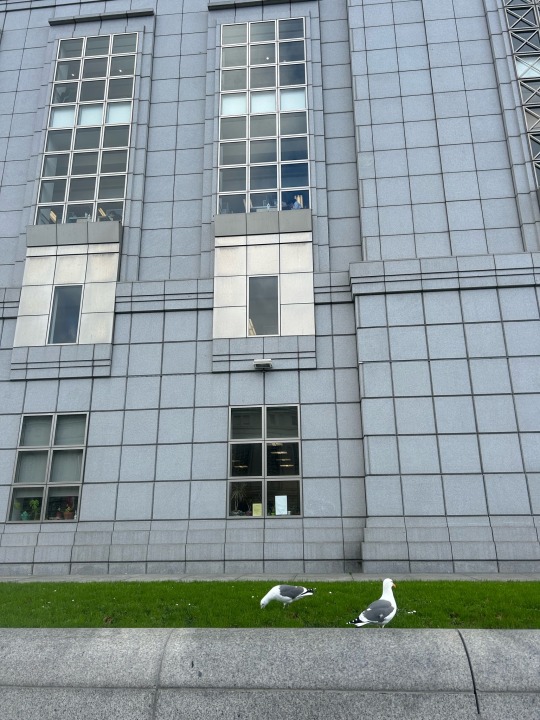
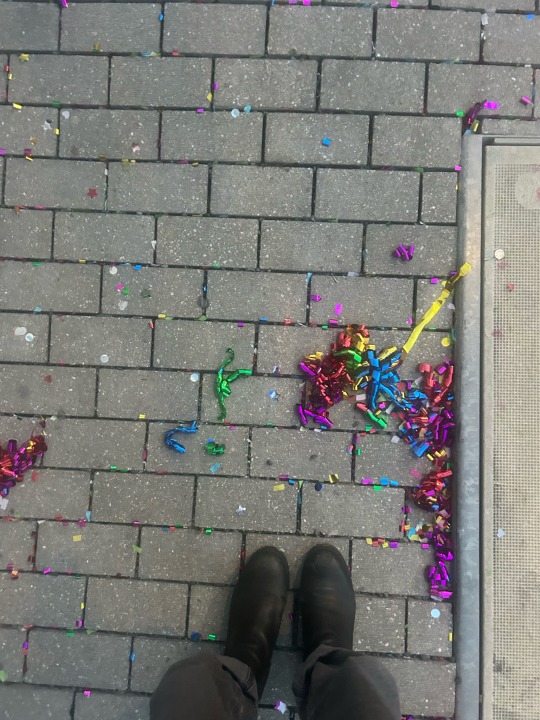
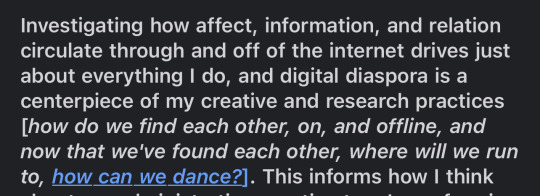

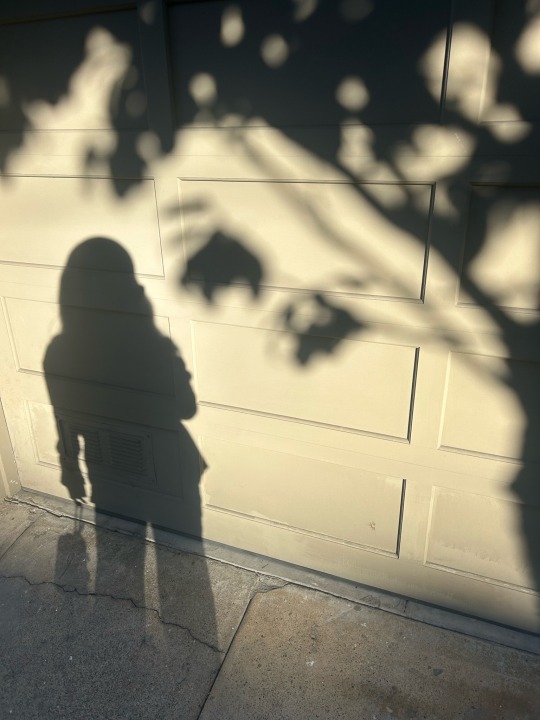


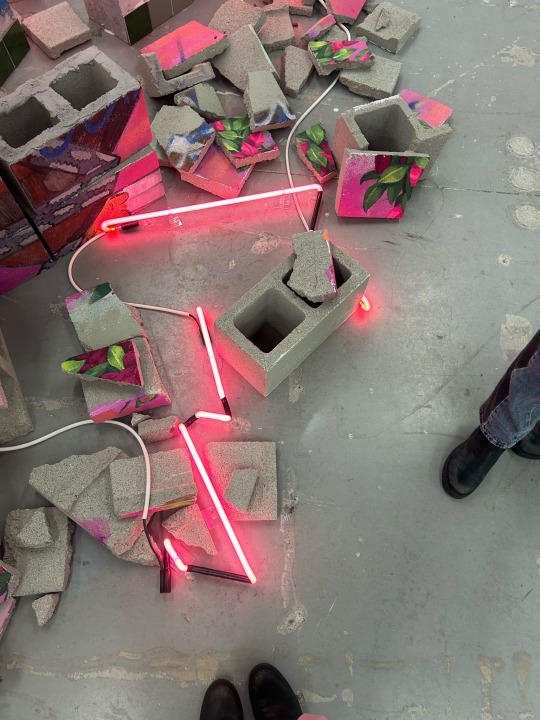

01.07.24 it’s winter and the cold is hitting 😵💫
the nondeterminism of detritus; once-detritus, assemblages-to-be;
there are cathedrals fractaling everywhere for the mind to see (or something?)
(bottom row left to right: charles gadeken; patrick martinez; rupy c tut)
0 notes
Text
In Rupy C. Tut’s Dreamlike Paintings, Figures Fold Into Landscapes in a Struggle to Belong
ArtNews http://dlvr.it/SzX6pb See More at: https://artistmichaelm.tumblr.com
0 notes
Text
Conversations | Musah Swallah, Rupy C. Tut, and Jason Wyman

"Sharing the impact of personal narratives and challenges on the work being presented and pointing to the smaller narratives that the work is visually and symbolically built on keeps the audience engaged, and offers to share the layered existence of immigrant artists.” – Rupy C. Tut
Visual artist Musah Swallah (IAP Newark ’18) recently collaborated with Rupy C. Tut (IAP Oakland ’19) and Jason Wyman (IAP Oakland Mentor ’18 and ’19) on a virtual studio tour and conversation about his art. The event was a great success, and the trio has much wisdom to impart on showcasing one's artwork in a live, online setting.
NYFA: Tell us about your process of coming together to collaborate on this project.
Musah Swallah: Our participation in the NYFA Immigrant Artist Mentoring program is what brought us together to collaborate on this project. Check-ins from NYFA program organizers such as Judy Cai regarding updates on my artistic career allowed us to stay connected and eventually collaborate on this project.
Jason Wyman: In 2019, I was a Mentor Artist in NYFA’s Immigrant Artist Mentoring Program in Oakland, CA. There, I met artist Rupy C. Tut. At the end of the program, I asked if any mentee would be interested in co-designing some sort of virtual convening of the immigrant artists in NYFA’s programs nationally, and Rupy stepped up.
Over the fall of 2019, Rupy and I—in collaboration with Judy Cai and Felicity Hogan—designed a series of Video Roundtables on topics including values clarification, opportunity identification, and decision making. We began these virtual conversations in February 2020 as COVID-19 started appearing in New York and shelter-in-place orders spread across the country, including the San Francisco Bay Area.
Rupy and I offered to continue convening immigrant artists nationally, centering on the question, “How do we support each other during this pandemic?” Musah attended one of our open sessions, and on the call he mentioned that he wouldn’t be able to showcase the art he created during his residency because COVID-19 made art openings impossible. Rupy and I offered to support Musah in hosting a virtual studio tour and artist talk.
NYFA: Do you have advice on how to put an online show together? For example, what platforms to use, length of time, ways of organizing, what works to show and the ones you shouldn’t, etc?
JW: My main piece of advice is to ask yourself, “what do I want to get out of showing my work online?” Musah wanted to share the paintings he created during his residency (and some from before his residency) with his community. This helped us focus the online show because we knew what works would be shown and who would be in attendance.
For Musah’s show, we determined that about 60 minutes would be best and a platform like Zoom would be the easiest. Zoom allowed us the opportunity to have both a gallery view of Musah’s whole community, but also a presentation view so we could show his artwork. We showed photographs of work and live views of the physical works. This allowed us to be able to both look at the pieces at a distance and see elements like paint strokes and materials up close.
Rupy C. Tut: I believe that the key to putting on an online artist talk/show is audience engagement and meaningful storytelling. In the context of immigrant artists, sharing the impact of personal narratives and challenges on the work being presented and pointing to the smaller narratives that the work is visually and symbolically built on keeps the audience engaged, and offers to share the layered existence of immigrant artists.
Communication can be a barrier within the art world for immigrant artists, especially when referencing cultures, traditions, and art forms that represent non-Eurocentric parts of the world. To address this barrier, I suggested guiding questions that can allow enough depth to share aspects of the rich cultural roots of the immigrant artist and their artwork, but also allow for a perspective on how their current work relates very crucially to the issues at hand in the larger global community. Guiding prompts can include sharing a unique origin story, purpose for approaching an opportunity or work, the evolution of thought on their journey, challenges and accomplishments, as well as impact on the future of their artistic practice.
NYFA: Rupy and Musah, as immigrant artists, what lessons or experiences can you share that might be useful for our readers to hear about?
MS: My advice for immigrant artists is to be patient, focus on your craft, and understand that regardless of the challenges you face, you will persevere. It is important that you persevere as an immigrant artist in order to share your story and the stories of those you represent in your art with the world. In order to persevere you need to find a niche—a community of like-minded artists who will offer support and advice when you need it the most. As an immigrant artist you will experience discrimination, but don't let that hold you back. Use it as inspiration. Use your art as a form of activism and bring to light the injustices you and others face as immigrants. Be patient, humble, and keep practicing your craft.
RCT: The most important lesson I have learned as an immigrant artist is the importance of my unique voice in my work and the presentation of my work as authentic to my individual mix of cultures and identities. I think immigrant artists have an individual voice that is also sometimes inclusive of family and community-centric values. The art world sometimes deludes us into diluting our stories to offer a version more “fitted” to the language and positionality of our surrounding art world pockets. I would advise immigrant artists to stay clear of this delusion and to avoid changing the core of their creative narratives to tailor to opportunities that fulfill a false sense of acceptance. Authentic work leads to a more successful life-long creative journey.
- Interview Conducted by Alicia Ehni, Program Officer and Kyle Lopez, REDC Fellow
This post is part of the ConEdison Immigrant Artist Program Newsletter #131. Subscribe to this free monthly e-mail for artist’s features, opportunities, and events. Learn more about NYFA Immigrant Artist Mentoring Program.
Image: Musah Swallah, Photo Credit: Fatoumata Magassa; Rupy C. Tut, Photo Credit: Lara Kaur; Jason Wyman, Photo Credit: Courtesy of the artist

#iap newsletter#iapnewsletter#conversations#interview#immigrant artist program#immigrantartistprogram#immigrant artist mentoring program#immigrantartistmentoringprogram#alicia ehni#aliciaehni#kyle lopez#kylelopez#jason wyman#jasonwyman#rupy c tut#rupyctut#musahswallah#musah swallah#nyfa learning#nyfalearning#instagram
0 notes
Video
SS17 Rootsgear x Rupy C. Tut 🌻🌷🌻🌷🌻🌷🌻🌷 Snatch it @rootsgearofficial @artbyrupy #rootsgear
1 note
·
View note
Link
Colonialism has wrecked large parts of the world. Even decades later, its effects continue to be felt. Rupy was interested in “tracing the roots of oppression to colonialism and to injustices associated with immigration.” Her work started as an “exploration of these two components in fueling the historic oppression of different communities in America.”
The presence, in the painting, of both the Republican and Democratic mascots, high up in the clouds, makes this work rise above partisanship and really address America as a nation, symbolized by the chained eagle.
She further adds “Within my own South Asian community, I closely observed how colonial oppression, in the form of patriarchal systems and values, trickled down and created unjust circumstances for specific community groups, particularly women.”
This is portrayed in the bent figures of the women bearing the pressure points of the palanquin. The oppressed sections of society, wherever they may be in the world, continuously feed the oppressor, who ironically cannot exist without the continuous sustenance that it sucks from them.
Rupy has endeavored to express, “how this machinery of oppression morphs into cycles of oppression and carries forward hundreds of years of neglect, hate, and suppression within our communities is the question that I sought to answer.” This is what she hoped the audience will reflect upon as they view the work and take in it’s various nuances.
#colonialism#imperialism#rupy c. tut#immigrant artist#immigrant#immigreat#artivism#artivist#south asian#sikh foundation#palo alto#california#bay area
0 notes
Text
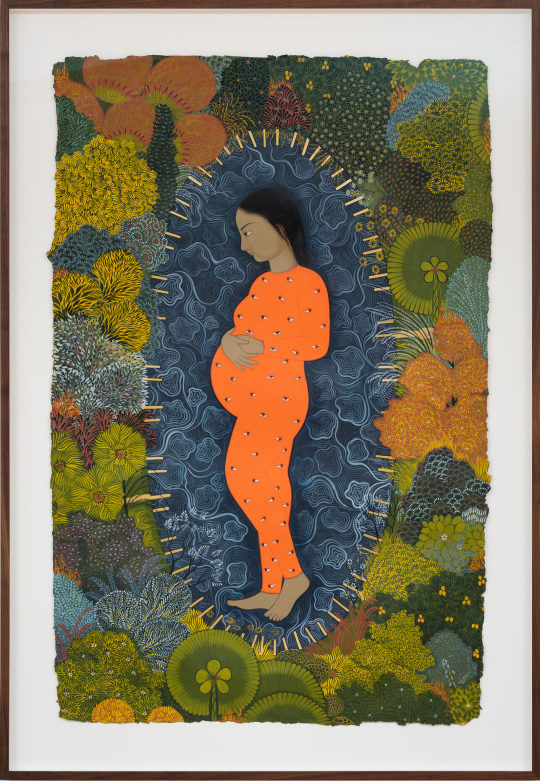
“Portrait of a Woman” (2023)
handmade pigments on hemp paper
Rupy C. Tut
23 notes
·
View notes
Text
arca de noé ilegal
https://www.youtube.com/watch?v=Wq-Nkh3ELpI
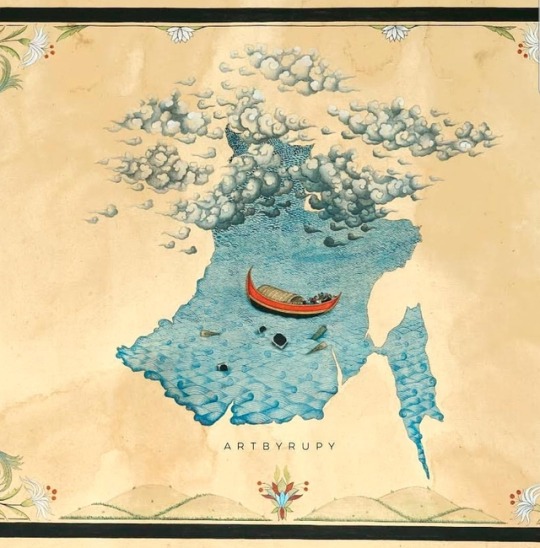
“O contorno de um mapa pode ser diferente
a cor da pele e os rostos podem ser trocados
o barco poderia ter sido um trem ou um avião
o mar poderia ter sido um deserto ou uma parede
as nuvens tempetuosas poderiam ter sido uma turba ou até mesmo um exército
as margens, o destino, ainda não estão à vista
a dor, a perda, ainda insuportáveis
a falta de moradia, a busca por refúgio, ainda em curso
a história ainda vive enquanto o refugiado marcha no escuro.”
Arte e texto por Rupy C. Tut
0 notes
Text
Alles neu macht der März
Eigentlich heißt es ja, alles neu macht der Mai. Doch hier trifft es eher auf den März zu. Was ist alles im letzten Monat passiert?
Erstens: Endlich ist Sommer. Das war zu Beginn des Monats mein Hauptgedanke. Wenn ich morgens aufwache, friere ich nicht mehr. Ich brauche keinen Schlafsack und zwei weitere Decken mehr zum Schlafen. Ich kann duschen ohne anschließend zu einer Eisskulptur zu erstarren. Und das Beste ist, endlich wieder draußen auf dem Dach schlafen. Für die Neulinge auf meinem Blog: Man kann nicht runterrutschen, da es eine Art Dachterrasse ist und somit ein Flachdach 😉. Dafür habe ich auch gerne meinen Schlafsack wieder rausgeholt. Nachts wird es doch noch recht kalt draußen. Naja, ich lebe halt auch in der Wüste, tagsüber heiß und nachts kalt. Damit wären wir auch schon bei dem nicht bedachten Nachteil. Am ANFANG war es angenehm warm, tagsüber. Doch jetzt am Ende des Monats ist es verdammt warm geworden. Wir haben teilweise an die 40°C tagsüber. Wenn ich dann Nachrichten aus Deutschland bekomme, wo es heißt: „Hier auf Fehmarn schneit es“, fühlt sich das schon ein bisschen strange an. Ich sitze hier in Indien und bewege mich nicht freiwillig aus dem Haus, da es zu warm ist. Und in Deutschland bewegt man sich nicht freiwillig aus dem Haus, da es zu kalt ist. Wobei man sagen muss, dass nach meinem Stand der Dinge, es auch in Deutschland langsam wärmer wird.
Anfang März wurde hier auch der Sommeranfang gefeiert, mit Holi. Dazu hatte ich ja schon einen Post geschrieben. Nach Holi änderten sich alle Zeiten. Hier läuft das etwas anders als in Deutschland. In Deutschland müssen alle ihren biologischen Tag-Nacht-Rhythmus umstellen. In Indien werden einfach die Schulzeiten geändert. Seit Holi beginnt die Schule früher und endet somit auch früher. Meine Arbeitsstelle ist zwar keine Schule, aber wir hängen doch eng mit der Schule zusammen. Es macht halt wenig Sinn etwas für Schulkinder anzubieten, wenn die alle in der Schule sind. Somit haben auch wir unsere Zeiten geändert. Da es mittags nun auch sehr heiß wird, bin ich mit meiner Butterfly-Klasse in den Vormittag gezogen. Die Kinder gehen nicht zur Schule, das bedeutet, sie können auch schon morgens um 10 Uhr im Center sein. Also findet die Klasse nun von 10 bis um 11 Uhr statt. Das sorgt auch einen Monat später noch für Probleme. Häufig brauche ich für den Weg von mir zu Hause bis zum Center eine halbe Stunde. Es ist nicht so, dass der Weg so weit ist. Das Center ist eigentlich nur 5 bis 10 Minuten Fußweg von mir entfernt. Doch muss ich auf dem Weg einige meiner Schüler*innen einsammeln. Das gestaltet sich sehr schwierig. Anfangen tut e, dass die Eltern erst anfangen ihre Kinder fertig zu machen, wenn ich dort ankomme. Teilweise wissen die Eltern auch gar nicht wo ihre Kinder sind. Auf die Frage, wo meine Schüler*innen sind, bekomme ich erst einen fragenden Blick und nach mehrmaligen Fragen wo sie sind und der Betonung von Sambhali eine Antwort. Die Antwort besteht in einer sehr ausschweifenden Handbewegung, die so viel sagt wie irgendwo dort. Damit kann das freie Feld neben den Häusern aber auch einer der Märkte in Setrawa gemeint sein. Mit etwas Glück und viel Rufe, taucht dann jemand von meinen Schüler*innen auf und holt die anderen oder sagt mi, wo ich sie finden kann. Inzwischen kenne ich einige der Lieblingsplätze du gehe da auch mal nachschauen. Ich finde es immer wieder traurig, dass Eltern nicht wissen, wo ihre Kinder sind. Ich spreche hier nicht von Jugendlichen, die Kinder aus der Butterfly-Klasse sind zwischen zwei und sieben Jahren alt. Doch die Eltern kümmern sich nicht um ihre Kinder. Die nächste Hürde ist der Marktplatz. Dort gibt es ganz viele Süßigkeiten und nun auch Eis zu kaufen. Häufig haben die Kinder auch noch nichts gegessen. Falls sie denn mal zu Hause waren oder dort zu mir gestoßen sind, bekommen die Kinder einen 10-Rupies-Schein in die Hand gedrückt, mit der Aussage, holt euch ein Eis. Nun ist aber Center und ein Eis ist kein angebrachtes Frühstück. Ich verstehe was die Mutter sagt, doch leider ist mein gesprochenes Hindi und Marwari nicht ausreichend um der Mutter zu verstehen, dass Eis kein Frühstücksersatz ist. Auch habe ich es schon mehrmals unseren Lehrerinnen erzählt und die haben mit den Eltern gesprochen, doch es kommt nicht an. Wenn ich dann endlich alle Kinder eingesammelt habe und die größte Hürde, den Marktplatz überwunden habe, erreichen wir recht zügig das Center.
Neben der Arbeit ist auch im Privaten im März einiges passiert. Moti, Aurelias Gastcousin, hat geheiratet. Die Hochzeit fand ich sehr schön. Aurelias Gastfamilie war sehr nett und man fühlte sich dort nicht so fremd. Klar ist, dass man als eine Weiße auf Veranstaltungen immer eine gewisse Aufmerksamkeit auf sich zieht und das viele auch ein Bild mit einem haben möchten. Das kann ich auch verstehen. Und ich habe auch kein Problem, wenn man mich höfflich fragt, ob wir zusammen ein Bild machen können. Trotz der gewissen Sonderrolle, die man dort einnimmt, habe ich mich absolut nicht fremd gefühlt. Geschweige denn den Eindruck gehabt, dass die Aufmerksamkeit nur auf mir lag. Leider habe ich nur einen Tag später eine ganz andere Erfahrung gemacht. Aurelia und ich waren auf die Hochzeit von der Cousine einer Freundin eingeladen worden, nach Jodhpur. Mir war von Anfang an klar, dass dort viele meiner Schüler*innen sein werden und dass das manchmal viele „Hi, Bye“ gibt (viele kleine Kinder rufen uns in Setrawa immer „Hi, Bye“ hinterher). Doch die kleinen Kinder aus meiner Butterfly-Class waren nicht das anstrengende. Viel anstrengender waren die Erwachsenen. Angefangen hat es schon zu Beginn. Da es in Jodhpur war, haben wir uns erst dort schick angezogen. Die Erwachsenen haben es nicht geschafft, trotz mehrmaligem Bitten unsererseits, uns alleine umziehen zu lassen. So ging es den ganzen Abend weiter. Ständig wurde wir gefragt, wie es uns geht und nie konnte man auch einfach mal 5min still sein. Einmal hatte ich kurz den Raum verlassen, da ich draußen kurz Luft schnappen wollte, da wurde ich gleich gefragt, warum ich ärgerlich sei. Die Antwort, dass ich nicht ärgerlich sei, sondern einfach nur 5min frische Luft brauche galt nicht. Und ich wurde noch mindestens 3min lang gefragt, warum ich ärgerlich sei. Hinzu kam, dass sich auch die eigenen Angehörigen mehr um uns gekümmert haben, als um das Brautpaar. Das war echt ärgerlich und die Hochzeit war mega anstrengend. Gott sei Dank gab es davor noch Motis Hochzeit. Dort habe ich erlebt, dass man auf einer Hochzeit auch Spaß haben kann und sie genießen kann. Zusammen mit dem Brautpaar. Im April erwartet mich jetzt noch die Hochzeit von einer Cousine meiner Gastschwester. Da bin ich mal gespannt, wie die wird und hoffe, dass ich die genauso genießen kann, wie die von Moti. Um noch einmal auf Motis Hochzeit zurückzukommen. Die Stimmung dort war eine ganz andere als bei den Hochzeiten in Indien zuvor. Zwar war es auch eine arrangierte Ehe, doch beide Heiratenden haben vorher ihr Einverständnis gegeben und waren bei der Auswahl des jeweilig anderen involviert. Zudem kannten sich die beiden auch schon vorher. Ich hatte den Eindruck, dass das in der Stimmung auf der Hochzeit zu spüren.
Leider gab es im März auch schlechte Nachrichten. Kurz nach der Hochzeit ist Aurelias Gastvater verstorben. Obwohl er schon länger sehr schwer krank war, kam der Tod doch sehr plötzlich und überraschend. Mein tiefstes Mitgefühl gilt der Familie. Ich hoffe, dass trotz des tragischen Verlustes des Vaters, Ehemannes, Onkels… die Familie neue Wege in ihrem Leben finden wird. So makaber wie es sich anhören mag, ich glaube, dass durch den Tod die Familie nun einige Wege nun leichter zu beschreiten sind. Die ganze Familie, insbesondere die drei Töchter haben sich 24/7 liebevoll und aufopfernd um ihren Vater gekümmert. Ich weiß auch, dass die Töchter eigentlich den Plan hatten etwas anderes zu studieren oder generell zu studieren. Leider konnten sie Ihre Träume nicht erfüllen, da sie nicht nach Jodhpur zum Studium gehen konnten. Denn es mussten immer mindestens zwei Personen zu Hause sein, um den Vater zu pflegen. Die älteste konnte deswegen gar nicht studieren und die mittlere Tochter musste einen Studiengang wählen, den sie als Fernstudium belegen kann. Vielleicht kann jetzt zumindest die Jüngste das studieren, was sie möchte. Ich wünsche dem Vater, dass es ihm nun besser geht, wo auch immer er sein wird (ob im Himmel oder als irgendwen anderes wiedergeboren). Was mich neben seinem Tod so traurig macht, ist, dass sein Tod wahrscheinlich bei einer adäquaten medizinischen Versorgung zu verhindern gewesen wäre. Doch leider lebte er in Indien und dazu noch in einem kleinen Dorf mitten in der Wüste. Wo das nächste halbwegs akzeptable Krankenhaus mindestens 3h entfernt ist. Und auch dort man ihm nicht wirklich helfen konnte.
0 notes
Text
COVID-19 | Presenting Your Work Online
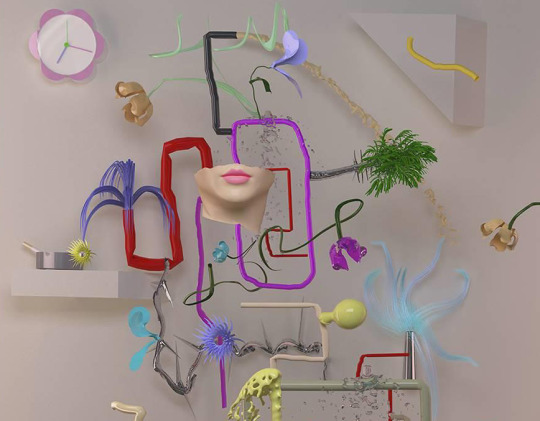
Artist and producer Jason Wyman helps you navigate ways of digitally connecting with your target audience.
Over the last five years, artist and producer Jason Wyman has convened a diverse, intergenerational network of youth media artists in virtual spaces of co-creation and exchange.
Stemming from their mentorship in NYFA’s Immigrant Artist Mentoring Program (IAP): Oakland, Wyman has also co-designed a series of video roundtables to connect NYFA’s national network of immigrant artists to each other through inquiry, storytelling, and skill and resource-sharing in partnership with IAP mentee Rupy C. Tut. Developed prior to the COVID-19 pandemic, these online spaces have responded to the growing critical needs of immigrant artists across the country.
Before engaging with technology, Wyman advises that you ask yourself: Why am I convening people (virtually)? The artist states that they convene people because they “want them to feel loved and included. That’s it. Everything else is designed around those two wants.”
Keep this in mind as you read the below Q&A, with tips from Wyman on how to use video platforms to share and discuss work, home equipment recommendations, and technical trouble-shooting advice.
NYFA: For those who are brand new to using video platforms to share their work and interact with their audience, can you give a brief overview on which platforms work best?
Jason Wyman: First, ask yourself: Why am I sharing what I think I want to share? Really interrogate that answer. If presenting your art is what you want to do, think about how you want that work presented and where your audience may be. Yes, Zoom may work for you. But! An “Ask Me Anything [about This One Piece of Art]” on Reddit, Facebook, Instagram, or Twitter might be a better option if your audience is already on one of those platforms. If you want to perform music, then livestreaming on Instagram/Facebook, YouTube, or Twitch may be the way to go. If you’re teaching an art class, Zoom is a good tool but consider that the place you teach may have a technology they require (e.g. some school districts only let folx communicate through Google Meet).
NYFA: How can artists of all disciplines make the best use of the equipment that they may already have on hand?
JW: The first step is to take inventory of all of the technologies you have access to. Do you have a computer? How about a smartphone? Or a tablet? Maybe you have a microphone with an audio board that plugs into your computer or an easel that could be used as a tripod. List everything out.
Additionally, list out all the ways you get online. This includes your internet and your cell phone coverage and even your landline. Notice what connections are stronger than others. For example, if you don’t have a strong internet connection, streaming video may not be the best option. Phone calls and conference call lines may work better for you.
Work with what you have and tailor your choices to what is the least frustrating. Making the transition to having to present digitally or virtually can be irksome and tedious. Knowing what you can and cannot control helps you navigate the technical issues that are bound to come up.
NYFA: What are your recommendations for looking and sounding your best on an online video platform?
JW: The first step is: Don’t beat yourself up about not looking and sounding your best. We are all learning. Every single one of us. And anyone who tells you they know everything about what’s best online is lying.
Our technology, cellular, and internet infrastructure in the United States is cobbled together and highly inequitable. It’s perfectly fine to figure out what works best for you along the way and make adjustments as you go. Still, there is ONE really simple tip for video: Don’t have your light source behind you. That includes lamps and windows and doors. Just notice where your light is coming from and make sure it isn’t at your back.
NYFA: What if you encounter technical difficulties mid-stream? Do you have any suggestions for how best to handle and regain steam?
JW: Let go of all expectations of your online experience even when you’ve tested and planned and done a practice session twice because the first one failed. I guarantee you it will all utterly fail again.
EMBRACE THE FAILURE. Don’t work against it. Don’t apologize for it. Instead, name it as it is occurring. It is helpful to tell folx when their mic is off or if their video stops working. One phrase I use when I start any virtual convening is, “Just a friendly reminder that all technology fails, just like we fail. So please be kind and gracious as we navigate our failures together.”
If technology keeps failing and you are getting frustrated because you don’t know what to do, name all of it and ask for help from folx on the call. Someone watching probably already has an answer or solution.
NYFA: For artists conducting Q&As, what are your top three tips for opening things up to a larger crowd and maintaining a sense of order (and time)?
JW: If you are convening folx online where you are presenting an artwork/song/film and you then want to take questions from the audience, get someone else to help facilitate the Q&A. This could be a friend or partner. It could be another artist. It could even be a student. The key here is that you want to be able to be present to answer the questions and not have to both answer the questions and facilitate the Q&A.
For those that have to facilitate their own Q&A (or those that are facilitating for someone else), taking stack (aka keeping an order) is crucial for your Q&A to be successful. Before you begin, ask who wants to ask questions and have people raise their hands. Notice whose hand is raised and start making an order.
Zoom also has a Q&A feature where folx can type in questions to ask the host. You can use it to collect questions and start your replies from that initial list. Along the way you can open it up if not enough questions have been asked.
NYFA: Lastly, for artists who introduce live video streaming into their practices, what are some of the best ways for maintaining engagement and encouraging audience members to return for future events and programs?
JW: First, look directly into the camera and warmly welcome people. Sometimes, you can be tempted to look at the screen instead of the camera. However, eye contact still matters and helps create a sense of being seen. When you are presenting your artwork via video and you are on video yourself, looking at the camera changes the relationship between you and your audience. It makes it more personal.
Next, welcome people as they arrive. On most platforms, you can see who is tuning in when. Don’t interrupt what you are saying or doing to say hi to someone. But when there is a natural break, welcome everyone that recently joined. It also helps to mention folx by name. Any way you can make it more welcoming means your audience will feel more included.
Finally, make space for others to share their reactions and experiences. Again, how this happens is platform-dependent. If you are livestreaming on Facebook, for example, you may not have someone join your stream to share their reaction, but they may share something via comments. Thank them for responding or commenting, and then read it aloud. If you feel comfortable, share your reaction to their reaction. Create a responsive feedback loop.
-Interview Conducted by Amy Aronoff, Senior Communications Officer
About Jason Wyman:
Jason Wyman is Senior Producer at The Alliance for Media Arts + Culture's Alliance Youth Media Network. They are an artist, writer, performer, curator, and educator who cultivates environments of peer exchange rooted in creative inquiry and multi-sensory pedagogies. They are a catholic (not capitalized) mystic conjuring ephemeral landscapes of astral and temporal origins; they are queerly complex. Wyman’s work has graced walls, stages, screens, classrooms, street corners, and museums including Asian Art Museum, Contemporary Jewish Museum, Santa Cruz Museum of Art and History, DeYoung Museum, SOMArts, the 16th Street BART Station, San Francisco Public Library, and many other venues. Find out more about Wyman’s youth media work and sign up for their e-newsletter.
If you need resources, please check our Emergency Grants page on NYFA’s website. We are updating it regularly as new funding comes in. You can find more articles on arts career topics by visiting the Business of Art section of NYFA.org. Sign up for NYFA News and receive artist resources and upcoming events straight to your inbox.
Image Detail: Katie Torn (Digital/Electronic Arts Finalist ’14), Still Life with Clock, 2012, render - ink jet on paper
#covid19#business of art#businessofart#jason wyman#jasonwyman#announcements#instagram#presenting work#profdev#professional development#presentingwork#conversations#amy aronoff#amyaronoff
0 notes
